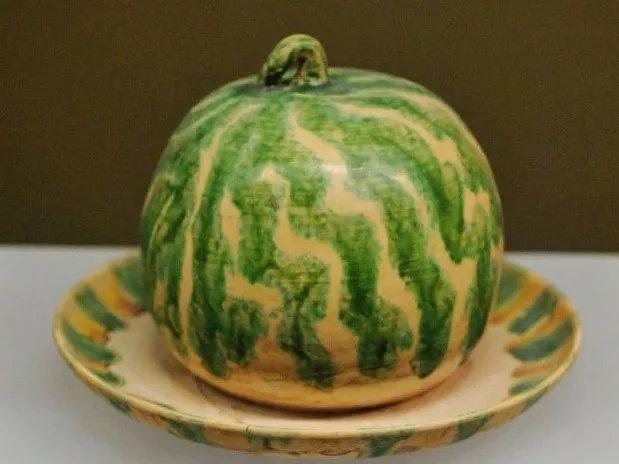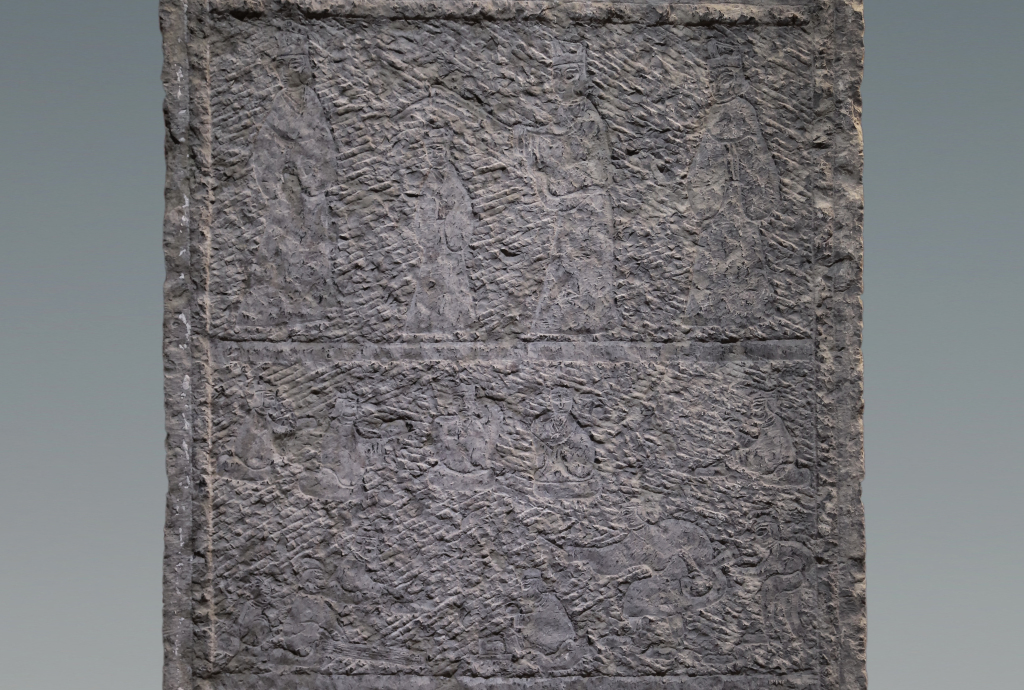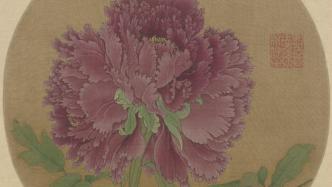
Grain Rain is the last solar term of spring and the misty rain in the south of the Yangtze River among the 24 solar terms in a year. The customs of the Guyu season include offering sacrifices to Cangjie, admiring peonies, and tasting Guyu tea.
I saw peonies in the Three Dynasties of Guyu. Wang Zhenbai's poem in the late Tang Dynasty includes: "Grain Rain washes the fiber and cuts it into white peonies. The exotic fragrance opens the jade and the light pink clay silver plate." Wang Wei's poem includes: "The green is bright and leisurely and quiet, and the red is light and deep. The heart of the flower The sorrow is gone, but the spring scenery does not know the heart."
Regarding tea tasting during Grain Rain, Qi Ji's poem in the Tang Dynasty includes "Thanks to the Master for Sending Tea": "In spring, before the rain in the valley, I pick fragrant smoke with my hands. The green is so tender that it is difficult to fill the cage, and it is easy to be clear and peaceful in the evening. Let's invite guests from the neighboring courtyard to try cooking Luohuaquan. The land is far away and we send it to each other. It’s another year when we don’t come.”
Appreciating peonies during the Three Dynasties of Guyu
As the saying goes, you can see peonies three times during Guyu. Appreciating peonies during the Grain Rain season has been practiced for thousands of years. At the Guyu Flower Fair in Heze, Luoyang and other places, people can appreciate all kinds of peonies and appreciate their wealth and gorgeous beauty. In addition, there is also a tradition of holding peony festivals in Qufu, Tai'an and other places in Shandong. At the flower festival, people can not only appreciate various varieties of peonies, but also participate in various peony-related activities, such as flower viewing, tea tasting, poetry recitation, etc., fully feeling the charm of Guyu culture. It is said that as early as the Tang Dynasty, when peonies bloomed in Luoyang, the whole city would go out to watch them. This is still the custom.
When it comes to poems describing peonies, there are many famous lines. In the Tang Dynasty, Liu Yuxi wrote, "The peonies in front of the court have no character, and the hibiscus on the pond is pure and emotionless. Peonies are the only true national beauty, and they move the capital when they bloom." Li Shangyin wrote, "I am a dream." "Zhongzhuan's colorful pen is about sending flowers and leaves to the morning clouds." Wang Wei's poems include: "The green color is leisurely and quiet, and the red clothes are light and deep, and the heart is sad, but the spring color does not know the heart."
From the Tang and Song Dynasties to the present, there are many famous paintings of peonies, including the scroll "Painting Peonies" by Zhao Chang in the Song Dynasty, the volume "Painting Peonies" by Fachang in the Song Dynasty, the volume "Painting Peonies" by Qian Xuan in the Yuan Dynasty, etc. In modern times, paintings by Yu Fei'an, Qi Baishi and others There are many masterpieces of peonies.
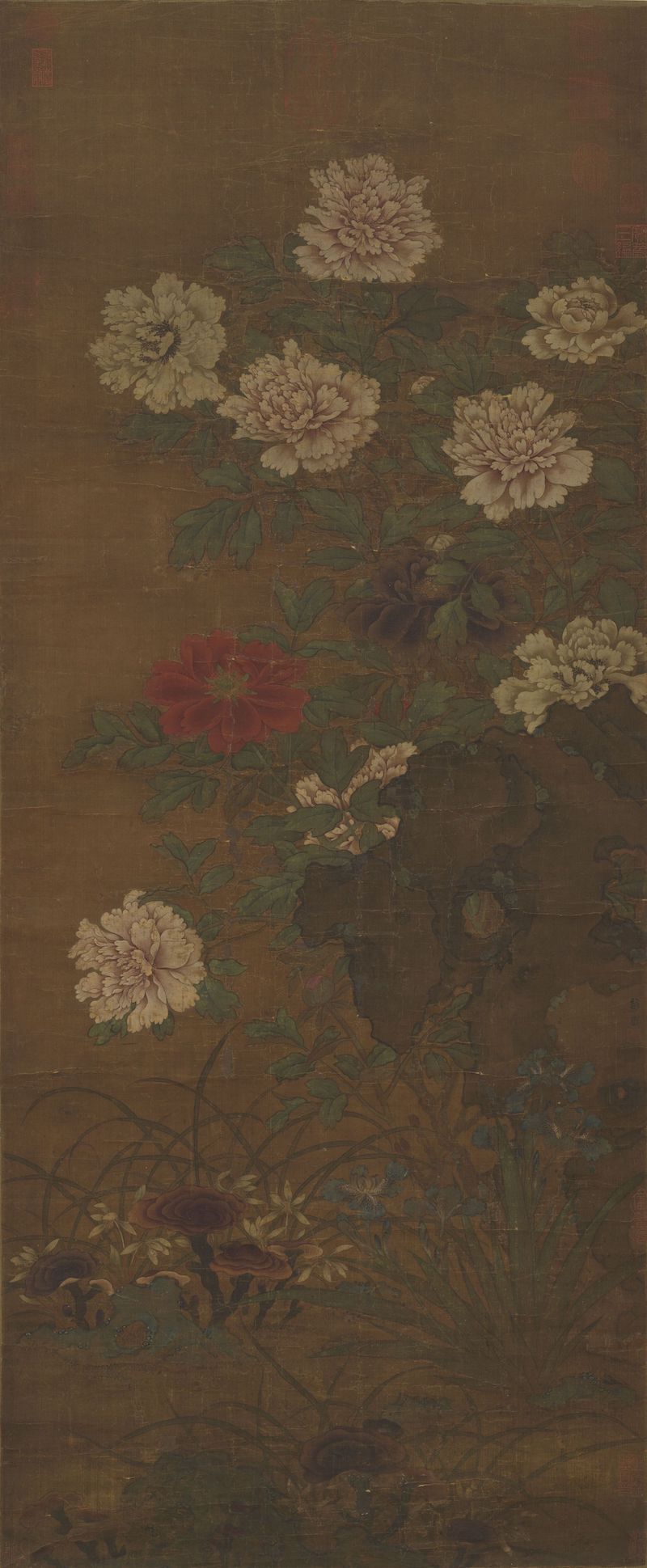
(Biography) scroll "Painting Peonies" by Zhao Chang of the Song Dynasty, collected by the National Palace Museum in Taipei
Zhao Chang (around the end of the 10th century), courtesy name Changzhi, was a native of Guanghan, Sichuan. He is good at painting flowers, fruits and vegetables from branches, and he calls himself "Sketching Zhao Chang". He cherished his paintings very much and never gave them to others easily. In his later years, he even bought back works that had fallen into the hands of others, so few of his works have been handed down.
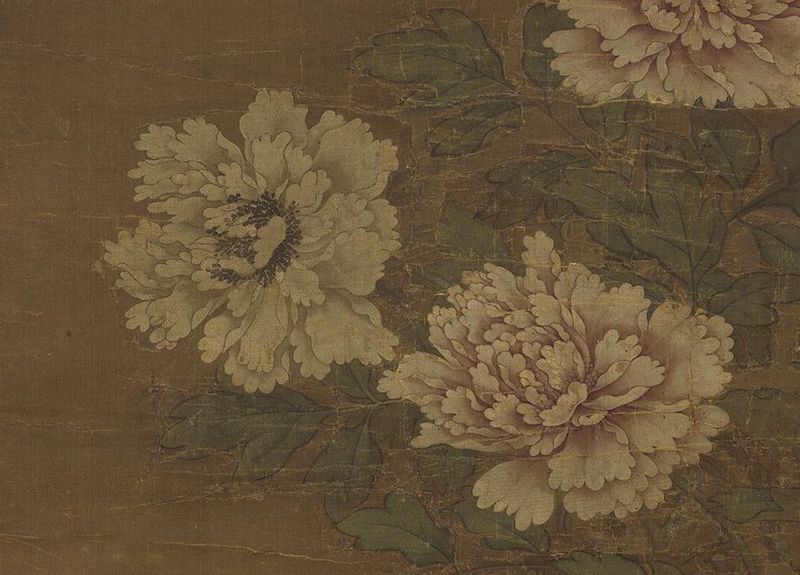
(Biography) scroll of "Painting Peonies" by Zhao Chang of the Song Dynasty (detail) collected by the National Palace Museum in Taipei
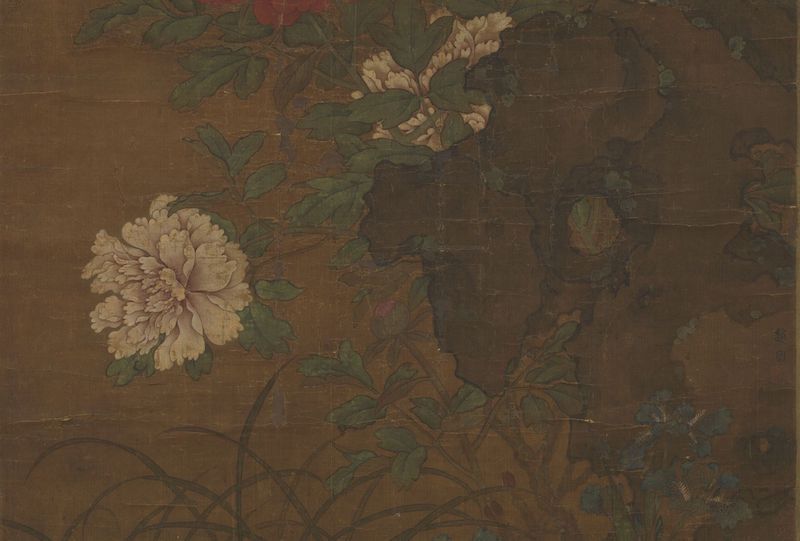
(Biography) scroll of "Painting Peonies" by Zhao Chang of the Song Dynasty (detail) collected by the National Palace Museum in Taipei
"Painting Peonies" is traditionally attributed to Zhao Chang of the Song Dynasty. Under the lake rocks there are irises, orchid grass, and Ganoderma lucidum, and behind the rocks there are peonies in full bloom, filling the picture. Although the silk is yellow and old, it still has a gorgeous feel. There is a seal of "Zhao Chang" on the right side of the lake stone, which is suspected to be a forgery of later generations.
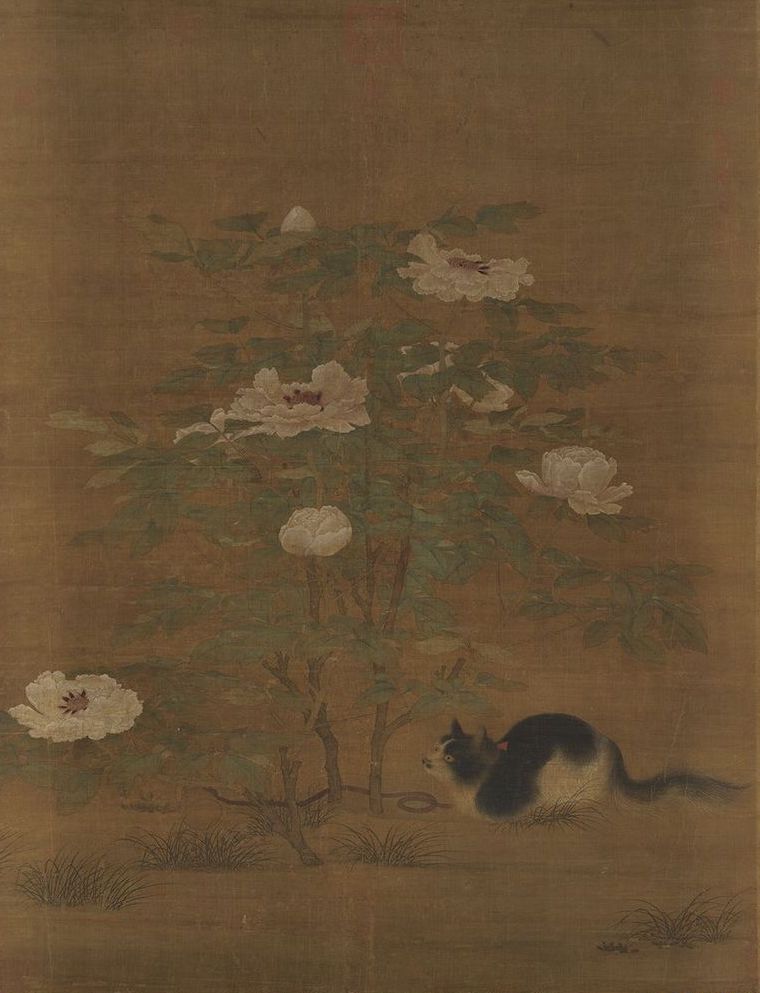
The Song Dynasty's "Wealthy Huali" scroll, collected by the National Palace Museum in Taipei
The Song Dynasty's "Wealthy Civet" depicts a civet tied with a stone bell under a bush of peonies. The cat's eyes are round and bright, as if it is peeping. The peonies are accurately depicted, with the flowers and leaves tilted upwards and turned sideways, using double hooks with fine lines. The writing is composed and applied with powder and color, which makes it quiet and thick. The dyeing and painting of cat cats uses both burnt ink and light pink. The ink is dark and full of three-dimensionality. Although the hairs are extremely fine, they are also very strong and powerful. The author's meticulous skill in observing and sketching can be seen from this.


Page of "Peony Pictures" by the Song Dynasty
The Song Dynasty's "Peony Picture" depicts a purple peony flower with a huge corolla and overlapping petals, which is delicate and luxurious, with green leaves on the left and right. The petals are richly layered and carefully painted. First, use a fine center-stroke pen to outline the petals, and then render them layer by layer with carmine. The stamens are dotted with light yellow, and the flowers and leaves are dyed with cyanine juice green. This picture page is richly crafted and extremely beautiful, with rich composition and bright and elegant colors.
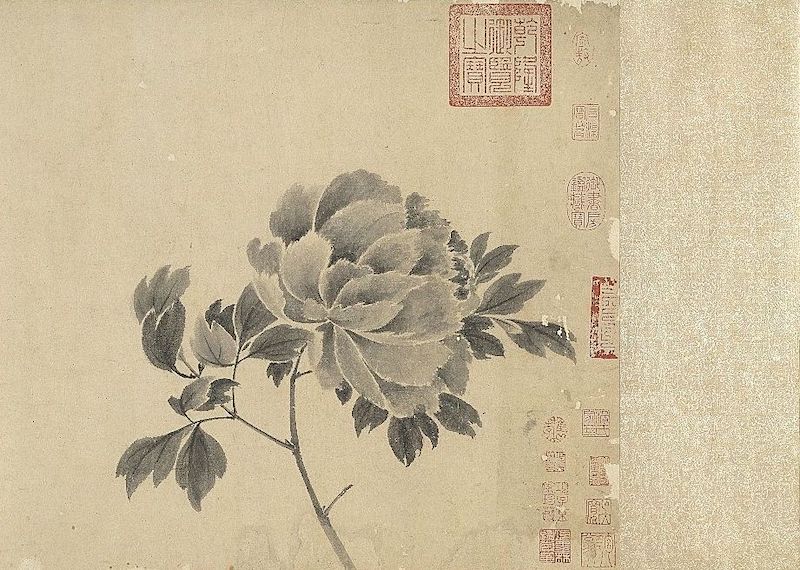
Song Fachang's "Sketching from Life" Volume (Part) Collection of the National Palace Museum, Taipei
Fachang (about the 13th century) was a native of Sichuan. His common surname was Li and his nickname was Muxi. His birth and death years are unknown. He lived in the Wannian Temple in Tiantai Mountain and had no apprentices. He painted dragons, tigers, apes and cranes, reed geese, landscapes, and figures, all with pen and ink. The style of writing is simple and simple, without any need for decoration, and the relics are mostly found in Japan.
Fachang's "Sketch from Life" volume contains Fachang's ink paintings of flowers, fruits, vegetables, feathers, feathers, etc. The sketches of the objects are almost ingenious, each flower and leaf are extremely delicate and there is no trace of rigid depiction. The painting begins with a boneless ink peony. The overlapping petals and leaves in the painting are all left blank, and the brush and ink are used. It is quite elegant and can bring out new ideas beyond the borders of other towns. The inscription is: "Xian Chun changed to Yuan Dynasty (1265) Mu Xi." At the end there are titles and postscripts of Xiang Yuanbian, Seng Yuanxin, Zha Shi, and collection seals of Wu Kuan, Dong Qi, Liang Zhangju and others.
Sacrifice to Cangjie
Paying tribute to Cangjie during the Grain Rain period is a traditional folk custom and folk sacrificial activity with a long history. No one has verified when it started. Sacrifice has lasted for thousands of years and has become a custom. In Shiguan Township, Baishui, Shaanxi Province, Cangjie Temple Fair is held every year during Guyu, and Cangjie is worshiped by the public or private people on Guyu day.
Regarding the legend of Guyu and Cangjie, "Huainanzi·Benjingxun" states: "Cangjie writes books, while the sky rains millet, and ghosts cry at night." It is said that Cangjie first coined the characters and was moved by the heavens' joy of raining millet. Only then could the rain produce hundreds of grains. Later, the solar term Grain Rain was also named.

The statue of Cangjie in ancient books
Cangjie was a historian during the Huangdi period and the founder of hieroglyphics. He was regarded as the ancestor of writing for generations. The Qingming Festival honors the emperor, and the Guyu Temple Fair honors Cangjie. As a kind of folk culture, the Guyu Temple Fair focuses on worshiping Cangjie, and features calligraphy exhibitions, singing duets, poetry leagues, social fires, and gong and drum competitions. The main forms of the sacrificial ceremony include sacrificial music, sacrificial utensils, sacrificial objects, respectful reading of sacrificial texts, and visits to ancestors' tombs.
There are many relics commemorating Cangjie across the country, including Cangjie Mausoleum, Cangjie Temple, and the Writing Platform. Among the many Cangjie and relics, four were built in the Han Dynasty: Nanle, Yucheng, Kaifeng and Baishui in Shaanxi; two were built in the Jin Dynasty: Shouguang and Dong'a in Shandong; two were built in the Song Dynasty: Henan Yangwu, Luoning.
Tasting Guyu tea
Guyu tea, also known as Yuqian tea, is a spring tea picked during the Guyu season. "Before the rain in the spring valley, we pick fragrant smoke with our hands. The green is so tender that it is hard to fill the cage, and the evening is clear and peaceful. We also invite guests from the neighboring courtyard to try cooking the Luohua Spring. We are far away from each other, and it is another year before we come." This is a description by Qi Ji in the Tang Dynasty. "Thanks to Master Zhong for Sending Tea" was written during the Grain Rain season.
Xu Cishu of the Ming Dynasty mentioned the importance of the tea picking season in his "Tea Book": "The Qingming Festival is too early, the Beginning of Summer is too late, and the time before and after Grain Rain is the right time."
Guyu tea is emerald green in color, soft in texture, rich in vitamins and amino acids, and has a pleasant aroma. It is said that drinking tea on the day of Guyu will clear fire, ward off evil spirits, improve eyesight, etc.
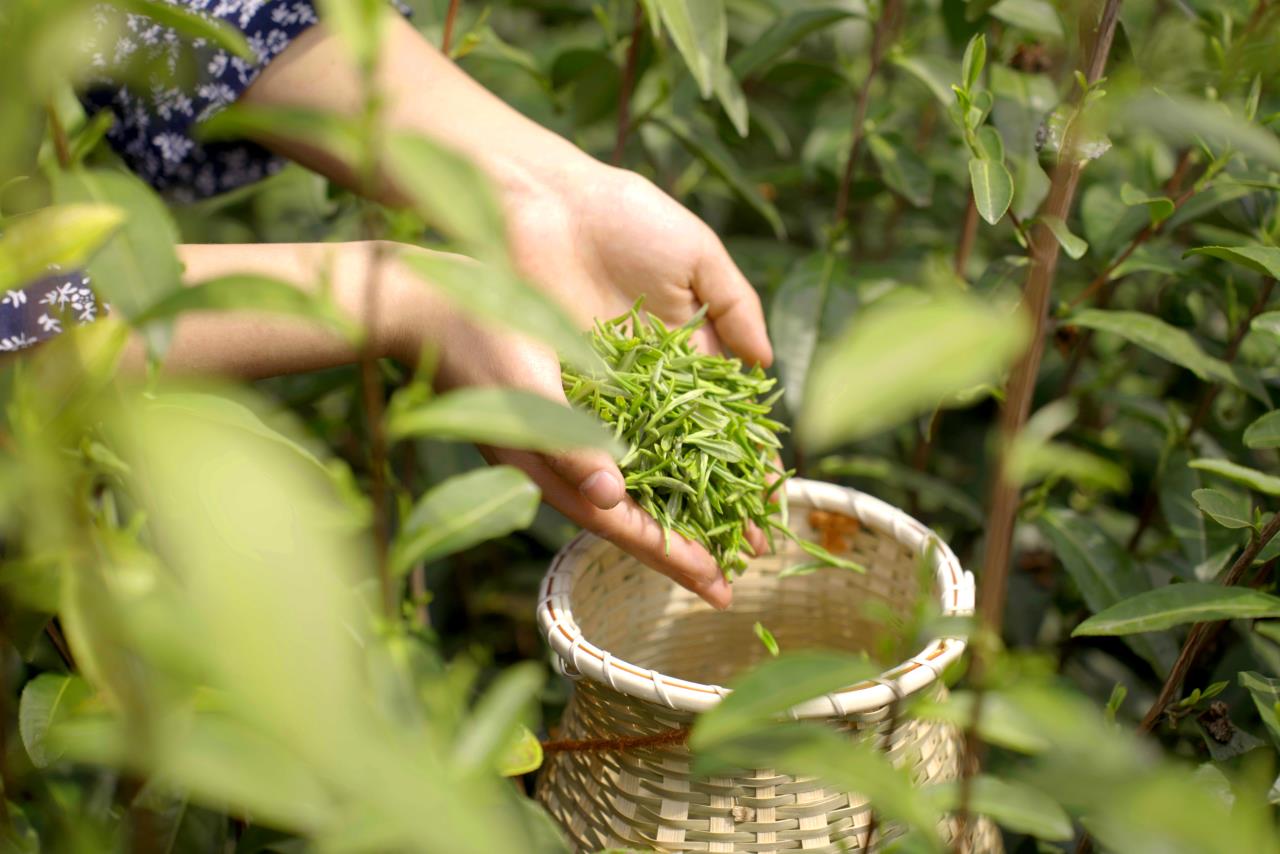
Suzhou spring tea picking scene

Wen Zhengming's "Tea Tasting Picture" scroll, collected by the National Palace Museum, Taipei
Among the four Wu sects, Wen Zhengming had the most outstanding tea knowledge. He loved tea, understood tea, and was proficient in tea ceremony. Huishu has many paintings of tea.
The "Tea Tasting Picture" collected in the National Palace Museum in Taipei was painted in the 10th year of Jiajing reign of Emperor Shizong of the Ming Dynasty (1531 AD). The postscript mentions Guyu: "Deep in the green mountains, there are absolutely no traces of dust, and the windows facing the water are open. Guyu The tea is good, the soup is boiling, and friends are coming."
The postscript after the poem says: "During Jiajing and Xinmao, the tea business in the mountains was flourishing. Lu Zizhuan (note: Lu Zizhuan is Lu Shidao, a disciple of Wen Gong Zhengming) came to visit, so he boiled it from the spring and tasted it. It is a good story. Zhengming system."
"Tea Tasting Picture" is a famous Ming Dynasty tea ceremony painting, which adopts realistic techniques. The picture describes the mountain tea party that day. There were three guests and hosts. Two of them were sitting in the room enjoying the joy of drinking each other, while the tea boy was busy boiling water in the water preparation room. At that time, another person not far away The situation is approaching
The whole picture is quiet and elegant, with luxuriant trees and clear pines, and beautiful scenery. It is also the ideal state of teahouse pursued by literati in the Ming Dynasty: "It is built with a small room next to the mountain house, with tea sets inside, and a child is taught to serve as tea servants for the elderly. Talking in the clear day, sitting still in the cold night, the leader of the secluded people, it is indispensable to waste."
In order to drink a good cup of tea, Wen Zhengming would also "mix water with talismans". Good tea requires good water. Wen Zhengming often sent his followers into the mountains to draw spring water to make tea. Because he was afraid that his followers would fetch water at will, he took the "bamboo talisman" as a token and gave it to the monks in Quanbian Temple. After the followers finished drawing water, they would take the bamboo talisman back with the water.
(Part of the information in this article is based on the National Palace Museum in Taipei)
